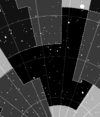Wikipedia:Today's featured article/December 12, 2016
Hydrus is a small constellation in the deep southern sky. Its first appearance was on a celestial globe published in 1598 in Amsterdam by the astronomer Petrus Plancius and the cartographer Jodocus Hondius. The first celestial atlas to depict it was Johann Bayer's Uranometria, in 1603. The French explorer and astronomer Nicolas Louis de Lacaille charted the brighter stars and gave their Bayer designations in 1756. Its name means "male water snake", as opposed to Hydra, a much larger constellation that represents a female water snake. Hydrus remains below the horizon for most Northern Hemisphere observers. The brightest star is the 2.8-magnitude Beta Hydri, also the brightest star within 15° of the south celestial pole. Pulsating between magnitude 3.26 and 3.33, Gamma Hydri is a variable red giant some 60 times the diameter of our Sun. Near it is VW Hydri, one of the brightest dwarf novae in the heavens. Four star systems have been found to have exoplanets to date, including HD 10180, which might bear up to nine planetary companions. (Full article...)

